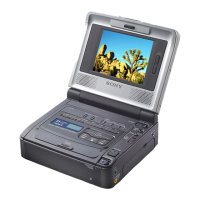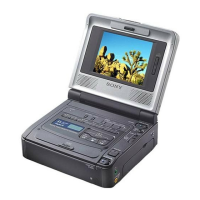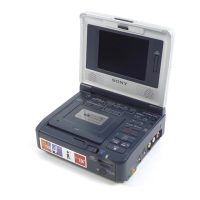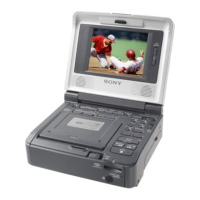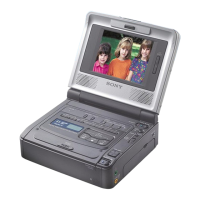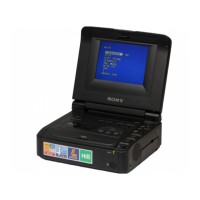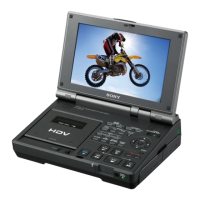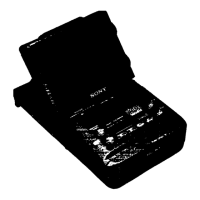Do you have a question about the Sony GV-D300 and is the answer not in the manual?
Section for recording model and serial numbers for reference.
Essential safety instructions, warnings, and symbol explanations for safe operation.
Proper disposal instructions for lithium-ion batteries.
Information regarding FCC rules and user caution for equipment operation.
Guidance on how to effectively read and use the manual.
Information about using mini DV cassettes with memory for enhanced features.
Note on TV color system compatibility required for viewing playback.
Warning regarding copyright laws and unauthorized recording of materials.
Important precautions for maintaining the VCR's condition and preventing damage.
List of accessories supplied with the VCR and instructions to check them.
Instructions for connecting the VCR to a TV for playback or display.
Step-by-step guide for installing the AC adaptor/charger.
Instructions on how to insert a mini DV cassette into the VCR.
Guide on how to play back a tape using basic controls.
Information on operating the VCR using a compatible Sony Remote Commander.
Details on different playback modes like still picture, scene search, and slow playback.
How to select and play back audio from dual soundtrack tapes.
Instructions for using the LASER LINK system for wireless playback.
Specific instructions for using LASER LINK with Sony TVs for enhanced functionality.
Options for powering the VCR using battery, house current, or car battery.
Details on using the "InfoLITHIUM" battery pack, including charging and capacity.
Step-by-step instructions to attach the battery pack to the VCR.
How to power the VCR using a car battery with the appropriate adapter.
How to adjust VCR settings via the menu system to enhance features.
Detailed explanation of individual mode settings like COMMANDER, REC MODE, AUDIO MODE.
Settings for title management, beeps, audio mixing, search, and data display.
Settings for TV input selection and resetting the VCR's date and time.
Displaying recording data like date, time, and settings on the TV screen.
How to connect and use the DV cable for high-quality editing.
How to connect and use A/V or S-video cables for editing.
Procedure for starting the assemble editing process between two VCRs.
How to create and store labels for mini DV cassettes.
Instructions for recording content from other VCRs or TV programs.
How to record TV programs using an optional TV tuner unit.
How to add new audio tracks to recorded tapes.
Step-by-step guide to adding new audio to a recorded tape.
How to superimpose preset or custom titles onto the video.
How to delete previously superimposed titles from the tape.
Creating and storing custom titles with up to 20 characters.
Definition and concept of assemble editing for creating new tapes.
How to connect the recording VCR using DV or A/V cables.
Configuring the VCR to control the recording VCR via remote.
A list of brands and their corresponding remote control modes for VCRs.
Performing a test to ensure the recording VCR can be controlled.
Procedure to measure the time lag between VCRs for accurate editing.
Calculating and setting timing adjustments for accurate recording start/stop.
How to select specific scenes (cuts) for editing by marking IN and OUT points.
How to review selected scenes before the final editing process.
How to reselect or adjust the IN and OUT points for selected scenes.
How to delete individual or all selected cuts from the editing sequence.
The final step of assembling and recording the selected scenes onto another tape.
Information on compatible cassette types and playback modes.
How copyright signals affect playback and recording.
Explanation of 12-bit and 16-bit audio modes for recording and playback.
Notes regarding accidental erasure, labeling, and storage of mini DV cassettes.
How to charge the internal vanadium-lithium battery for VCR settings.
Procedure for resetting the VCR's internal clock and date.
Information on the "InfoLITHIUM" battery pack, its usage, and battery consumption display.
Tips for getting more accurate battery level readings and reasons for discrepancies.
How to prevent and handle moisture condensation inside the VCR.
Instructions for cleaning the VCR's video heads to ensure picture quality.
Important precautions for operating the VCR safely.
Guidelines for handling video tapes correctly to prevent damage.
General care instructions for cleaning and maintaining the VCR unit.
Precautions related to the AC adaptor/charger, including charging and general use.
Information on using the VCR with different power sources abroad.
Guide to TV color systems (NTSC, PAL, SECAM) for international use.
Solutions for problems related to the VCR not powering on or battery issues.
Troubleshooting steps for tape transport, cassette removal, and indicator issues.
Solutions for no sound, low sound, or issues with added audio during playback.
Troubleshooting for titles not displaying, recording, or cassette labels not recording.
Solutions when date search, title search, or cassette memory indicators do not function.
Troubleshooting for picture quality, monitoring during editing, and VCR warmth.
Solutions for problems with the AC adaptor/charger indicators.
How to interpret the VCR's self-diagnosis codes for troubleshooting.
Labels and locations of major parts on the VCR unit.
Numbered identification of all VCR controls, indicators, and connectors.
Explanation of indicators shown on the TV screen during VCR operation.
Explains general conditions that trigger warning indicators and how to interpret them.
Details the meaning of various indicators for tape status, battery, moisture, and other issues.
Details on VCR recording systems, signals, inputs/outputs, and LASER LINK.
General VCR specs including power, temperature, dimensions, mass, and accessories.
Technical details for the AC adaptor/charger, including power, temperature, dimensions, and mass.
Section for recording model and serial numbers for reference.
Essential safety instructions, warnings, and symbol explanations for safe operation.
Proper disposal instructions for lithium-ion batteries.
Information regarding FCC rules and user caution for equipment operation.
Guidance on how to effectively read and use the manual.
Information about using mini DV cassettes with memory for enhanced features.
Note on TV color system compatibility required for viewing playback.
Warning regarding copyright laws and unauthorized recording of materials.
Important precautions for maintaining the VCR's condition and preventing damage.
List of accessories supplied with the VCR and instructions to check them.
Instructions for connecting the VCR to a TV for playback or display.
Step-by-step guide for installing the AC adaptor/charger.
Instructions on how to insert a mini DV cassette into the VCR.
Guide on how to play back a tape using basic controls.
Information on operating the VCR using a compatible Sony Remote Commander.
Details on different playback modes like still picture, scene search, and slow playback.
How to select and play back audio from dual soundtrack tapes.
Instructions for using the LASER LINK system for wireless playback.
Specific instructions for using LASER LINK with Sony TVs for enhanced functionality.
Options for powering the VCR using battery, house current, or car battery.
Details on using the "InfoLITHIUM" battery pack, including charging and capacity.
Step-by-step instructions to attach the battery pack to the VCR.
How to power the VCR using a car battery with the appropriate adapter.
How to adjust VCR settings via the menu system to enhance features.
Detailed explanation of individual mode settings like COMMANDER, REC MODE, AUDIO MODE.
Settings for title management, beeps, audio mixing, search, and data display.
Settings for TV input selection and resetting the VCR's date and time.
Displaying recording data like date, time, and settings on the TV screen.
How to connect and use the DV cable for high-quality editing.
How to connect and use A/V or S-video cables for editing.
Procedure for starting the assemble editing process between two VCRs.
How to create and store labels for mini DV cassettes.
Instructions for recording content from other VCRs or TV programs.
How to record TV programs using an optional TV tuner unit.
How to add new audio tracks to recorded tapes.
Step-by-step guide to adding new audio to a recorded tape.
How to superimpose preset or custom titles onto the video.
How to delete previously superimposed titles from the tape.
Creating and storing custom titles with up to 20 characters.
Definition and concept of assemble editing for creating new tapes.
How to connect the recording VCR using DV or A/V cables.
Configuring the VCR to control the recording VCR via remote.
A list of brands and their corresponding remote control modes for VCRs.
Performing a test to ensure the recording VCR can be controlled.
Procedure to measure the time lag between VCRs for accurate editing.
Calculating and setting timing adjustments for accurate recording start/stop.
How to select specific scenes (cuts) for editing by marking IN and OUT points.
How to review selected scenes before the final editing process.
How to reselect or adjust the IN and OUT points for selected scenes.
How to delete individual or all selected cuts from the editing sequence.
The final step of assembling and recording the selected scenes onto another tape.
Information on compatible cassette types and playback modes.
How copyright signals affect playback and recording.
Explanation of 12-bit and 16-bit audio modes for recording and playback.
Notes regarding accidental erasure, labeling, and storage of mini DV cassettes.
How to charge the internal vanadium-lithium battery for VCR settings.
Procedure for resetting the VCR's internal clock and date.
Information on the "InfoLITHIUM" battery pack, its usage, and battery consumption display.
Tips for getting more accurate battery level readings and reasons for discrepancies.
How to prevent and handle moisture condensation inside the VCR.
Instructions for cleaning the VCR's video heads to ensure picture quality.
Important precautions for operating the VCR safely.
Guidelines for handling video tapes correctly to prevent damage.
General care instructions for cleaning and maintaining the VCR unit.
Precautions related to the AC adaptor/charger, including charging and general use.
Information on using the VCR with different power sources abroad.
Guide to TV color systems (NTSC, PAL, SECAM) for international use.
Solutions for problems related to the VCR not powering on or battery issues.
Troubleshooting steps for tape transport, cassette removal, and indicator issues.
Solutions for no sound, low sound, or issues with added audio during playback.
Troubleshooting for titles not displaying, recording, or cassette labels not recording.
Solutions when date search, title search, or cassette memory indicators do not function.
Troubleshooting for picture quality, monitoring during editing, and VCR warmth.
Solutions for problems with the AC adaptor/charger indicators.
How to interpret the VCR's self-diagnosis codes for troubleshooting.
Labels and locations of major parts on the VCR unit.
Numbered identification of all VCR controls, indicators, and connectors.
Explanation of indicators shown on the TV screen during VCR operation.
Explains general conditions that trigger warning indicators and how to interpret them.
Details the meaning of various indicators for tape status, battery, moisture, and other issues.
Details on VCR recording systems, signals, inputs/outputs, and LASER LINK.
General VCR specs including power, temperature, dimensions, mass, and accessories.
Technical details for the AC adaptor/charger, including power, temperature, dimensions, and mass.
| Video Format | Digital8 |
|---|---|
| Tuner | No |
| Playback | 8mm, Hi8, Digital8 |
| Inputs | S-Video, Composite, Audio |
| Outputs | S-Video, Composite, Audio |
| Weight | 1.2 kg (2.6 lbs) |
| Screen Size | 2.5 inches |
| Audio | Stereo |
| Power Source | AC adapter, Battery |
